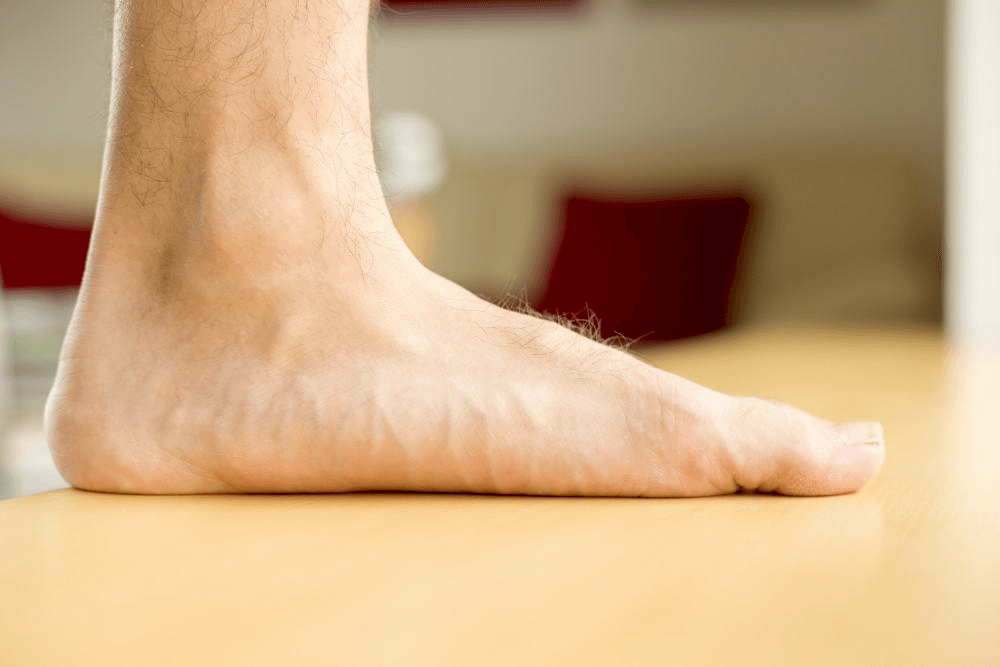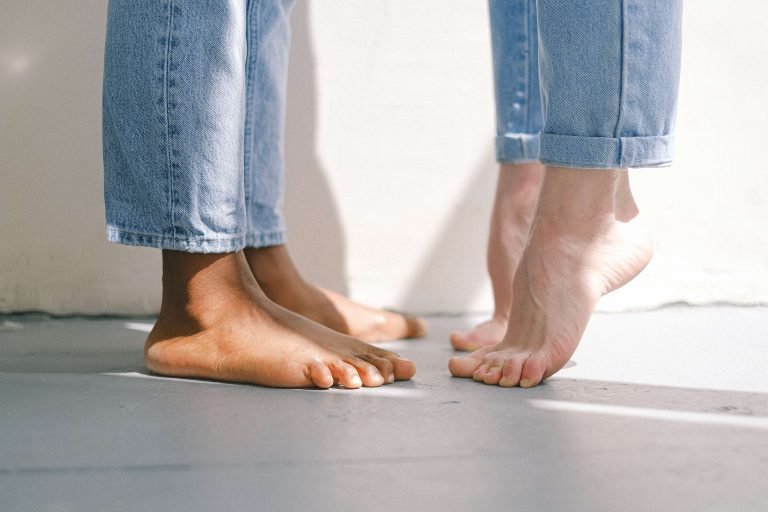Flat feet, also known as fallen arches, is a condition where the arches of the feet collapse, causing the entire sole to come into complete or near-complete contact with the ground. This condition can occur in one or both feet and can be present from birth or develop over time due to various factors. Understanding flat feet is crucial as it can affect a person’s mobility and quality of life.
Key Takeaways: What Are Flat Feet?
- Definition and Causes:
- Flat feet, also known as fallen arches, occur when the arches of the feet collapse, leading the entire foot to touch the ground.
- Causes include genetics, injury, obesity, arthritis, and certain health conditions like diabetes.
- Symptoms and Diagnosis:
- Common symptoms include foot pain, swelling, and difficulty standing on toes.
- Diagnosis typically involves a physical examination and imaging tests like X-rays or MRI.
- Types of Flat Feet:
- Rigid Flat Feet: The arch is absent both when standing and sitting.
- Flexible Flat Feet: The arch is visible when not bearing weight but disappears upon standing.
- Complications:
- Flat feet can lead to issues such as plantar fasciitis, Achilles tendinitis, and shin splints due to altered gait and posture.
- Treatment Options:
- Non-surgical treatments include orthotics, physical therapy, weight management, and anti-inflammatory medications.
- Surgical options are considered for severe cases and may involve tendon repair or bone realignment.
- Lifestyle and Management:
- Regular exercise, maintaining a healthy weight, and wearing supportive footwear can help manage symptoms and prevent complications.
- Custom orthotics provide additional support and relieve pressure on the arches.
- Children and Flat Feet:
- Flat feet are common in children and often resolve by adolescence. Persistent cases may require medical evaluation and treatment.
For comprehensive information and expert tips on managing flat feet, visit HowToKings.com.

Causes of Flat Feet
Genetic Factors
Flat feet can be hereditary, meaning they can run in families. If one or both parents have flat feet, there’s a higher chance that their children might also develop the condition.
Developmental Factors
Many children are born with flat feet, but in most cases, the arches develop by age six. However, some individuals may never ever develop flat feet or proper arches.
Injury and Damage
Injuries to normal arch of the foot or ankle, such as fractures, dislocations, or tendon damage, can lead to flat feet. Posterior tibial tendon dysfunction, where the tendon along the inside of the ankle is weakened or torn, can also lead to a collapsed or fallen foot arch in adulthood. Over time, the damage can weaken the tendons that support the arch.
Health Conditions: Posterior Tibial Tendon Dysfunction
Certain medical conditions, such as arthritis, diabetes, and obesity, can contribute to the development of flat feet. These conditions can weaken the tendons and ligaments in the feet, leading to a collapse of the arch.
Age and Wear and Tear
As people age, the tendons in the feet can stretch and weaken, resulting in flat feet. This more flexible flatfoot is often due to the natural wear and tear on the tendons over time.
Symptoms of Flat Feet
Foot Pain and Discomfort
One of the most common symptoms of flat feet is pain in the feet, especially in the arch or heel. This pain can extend to the ankles, knees, hips, and lower back due to the misalignment caused by the lack of an arch.
Swelling
Flat feet can cause swelling along the inside of the ankle and the arch of the foot. This swelling is often due to inflammation of the tendons and ligaments that support the foot.
Difficulty Standing on Tiptoes
Individuals with flat feet may find it challenging to stand on their tiptoes due to the lack of support from the arch. Another symptom associated with flat feet is toe drift, where the toes and front of the foot point outward due to the ankle over-pronating.
Fatigue in the Feet and Legs
Flat feet can lead to fatigue in the feet and legs, especially after prolonged periods of standing or walking. This fatigue is often due to the extra strain placed on the muscles and ligaments to support the flat foot.
Diagnosing Flat Feet
Physical Examination
A healthcare provider can often diagnose flat feet through a physical examination. They will observe the feet while standing and walking to see how the arches function.
Imaging Tests
In some cases, imaging tests such as X-rays, CT scans, or MRIs may be used to assess the bones, joints, and tendons in the flat feet diagnosed. These tests can help determine the severity of the condition and identify any underlying issues contributing to flat feet.
Treatment Options for Flat Feet
Non-Surgical Treatments
Orthotic Devices
Orthotic devices, such as custom-made arch supports, can help alleviate pain and provide support to the feet. These devices can be inserted into shoes to provide extra cushioning and support for the arch.
Physical Therapy
Physical therapy can be beneficial for individuals with flat feet. Exercises that strengthen the muscles and tendons in the feet and legs can help improve arch support and reduce pain.
Medications
Nonsteroidal anti-inflammatory drugs (NSAIDs) can help reduce pain and inflammation associated with people with flat feet. These medications can be taken orally or applied topically to the affected area.
Lifestyle Changes
Maintaining a healthy weight can reduce the strain on the feet and help alleviate symptoms of flat feet. Wearing supportive shoes and avoiding high heels can also provide relief.
Surgical Treatments
Tendon Transfer
In severe cases of flat feet, a tendon transfer may be performed. This procedure involves transferring a tendon from another part of the body to the foot to support the front foot arch further.
Osteotomy
An osteotomy involves cutting and repositioning the bones in the foot to improve alignment and support the arch.
Arthrodesis
Arthrodesis, or joint fusion, involves fusing the bones in the foot to provide stability and support to the arch. This procedure is typically reserved for severe cases that do not respond to other treatments.

Prevention of Flat Feet
Maintain a Healthy Weight
Maintaining a healthy weight can reduce the strain on the feet and help prevent the development of flat feet.
Wear Supportive Footwear
Wearing shoes with good arch support and cushioning can help prevent flat feet. Avoiding high heels and shoes with inadequate support can also reduce the risk.
Strengthening Exercises
Regularly performing exercises that strengthen the muscles and tendons in the feet and legs can help maintain proper arch support and prevent flat feet.
Addressing Injuries Promptly
Promptly addressing foot and ankle injuries and following appropriate rehabilitation protocols can help prevent the development of flat feet.
Living with Flat Feet
Coping Strategies
Living with flat feet can be challenging, but there are strategies that can help individuals manage their symptoms and improve their quality of life.
Proper Footwear
Wearing supportive footwear with adequate arch support and cushioning can help alleviate pain and provide comfort.
Custom Orthotics
Using custom orthotic devices can provide additional support and reduce strain on the feet.
Regular Exercise
Engaging in regular exercise that focuses on strengthening the muscles and tendons in the feet and legs can help improve arch support and reduce pain.
Weight Management
Maintaining a healthy weight can reduce the strain on the feet and help alleviate symptoms of flat feet.
Complications and Management of Flat Feet
Potential Complications
Pain and Discomfort
Flat feet can lead to chronic pain and discomfort in the feet, ankles, and lower legs due to the lack of proper arch support. This pain can extend to the knees, hips, and lower back as the body’s alignment is affected.
Increased Risk of Injuries
Individuals with flat feet are more susceptible to injuries such as shin splints, Achilles tendonitis, plantar fasciitis, and stress fractures. The altered biomechanics and increased stress on the muscles and tendons can contribute to the risk factors these injuries.
Arthritis
Flat feet can lead to the development of arthritis in the feet and ankles. The abnormal distribution of weight on foot joints and increased stress on the joints can cause wear and tear, leading to arthritis over time.
Difficulty with Physical Activities
Flat feet can make it challenging to participate in physical activities such as running, jumping, and standing for prolonged periods. This can impact an individual’s ability to engage in sports and other recreational activities.
Management and Treatment Options
Non-Surgical Treatments
Orthotic Devices
Custom orthotic devices can provide the necessary support to the arches and alleviate pain. These devices can be tailored to the individual’s foot shape and condition, offering better support and alignment to develop arches.
Physical Therapy
Physical therapy can help strengthen the muscles and tendons in the feet and legs. Specific exercises can improve arch support, reduce pain, and enhance overall foot function.
Medications
Nonsteroidal anti-inflammatory drugs (NSAIDs) can help manage pain and inflammation associated with flat feet. These medications can be taken as needed to alleviate symptoms of flexible flat foot.
Lifestyle Changes
Maintaining a healthy weight, wearing supportive footwear, and avoiding high heels can help manage flat feet. Proper footwear can provide the necessary arch support and cushioning to reduce pain and discomfort.
Surgical Treatments
Tendon Transfer
In severe cases, a tendon transfer may be performed to support the arch. This procedure involves transferring a tendon from another part of the body to the foot to provide additional support rigid flat foot.
Osteotomy
Osteotomy involves cutting and repositioning the bones in the foot to improve alignment and support the arch. This procedure can help restore proper foot function and reduce pain.
Arthrodesis
Arthrodesis, or joint fusion, involves fusing the bones in the foot to provide stability and support. This procedure is typically reserved for severe cases that do not respond to other treatments.
Preventive Measures for Flat Feet
Maintain a Healthy Weight
Maintaining a healthy weight can reduce the strain on fallen arch of the feet and help prevent the development of flat feet. Excess weight can put additional stress on the tendons and ligaments, leading to a collapse of the arch.
Wear Supportive Footwear
Wearing shoes with good arch support and cushioning can help prevent flat feet. Avoiding high heels and shoes with inadequate support can also reduce the risk developing flat feet.
Strengthening Exercises
Regularly performing exercises that strengthen the muscles and tendons in the feet and legs can help maintain proper arch support and prevent flat feet. Exercises such as toe curls, calf raises, and arch lifts can be beneficial.
Addressing Injuries Promptly
Promptly addressing foot and ankle injuries and following appropriate rehabilitation protocols can help prevent the development of flat feet. Proper care and rehabilitation can ensure that the tendons and ligaments heal correctly.
Living with Flat Feet
Coping Strategies
Proper Footwear
Wearing supportive footwear with adequate arch support and cushioning can help alleviate pain and provide comfort. Custom orthotics can provide additional support and reduce strain on the feet.
Custom foot Orthotics:
Using custom orthotic devices can provide additional support and reduce strain on the feet. These devices can be tailored to the individual’s foot shape and condition, offering better support and alignment.
Regular Exercise
Engaging in regular exercise that focuses on strengthening the muscles and tendons in the feet and legs can help improve arch support and reduce pain. Exercises such as swimming, cycling, and low-impact activities can be beneficial.
Weight Management
Maintaining a healthy weight can reduce the strain on the feet and help alleviate symptoms of flat feet. Proper diet and regular exercise can help achieve and maintain a healthy weight.
One Way to Think About This…
Flat feet, while common, can lead to significant discomfort and mobility issues if not properly managed. Understanding the causes, symptoms, and treatment options is crucial for managing this condition effectively. Whether through lifestyle changes, non-surgical treatments, or surgical interventions, individuals with flat feet can find relief and improve their quality of life.
For more in-depth guides and expert advice on managing flat feet and other health-related topics, visit HowToKings. Our blog provides valuable insights and practical tips to help you make informed decisions about your health and wellness.
*Editor’s Note: The information in this article is intended for your educational use only and is not a substitute for professional medical advice, diagnosis, or treatment. Always seek the advice of your physician or other qualified health providers with any questions you may have regarding a medical condition before undertaking any diet, supplement, fitness, or other health programs.




